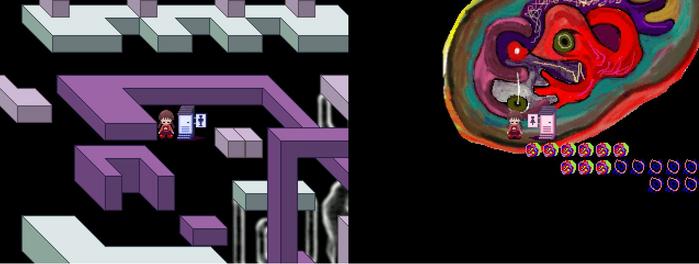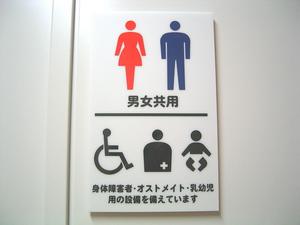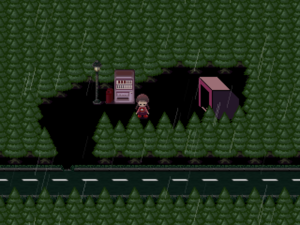>Mt.kiki No edit summary |
No edit summary |
||
| (29 intermediate revisions by 7 users not shown) | |||
| Line 19: | Line 19: | ||
==[[ | [[File:Japanese_toilet_sign.jpg|thumb|Japanese sign of the toilet]] | ||
==Restroom ([http://en.wikipedia.org/wiki/Gender_identity Gender identity])== | |||
Gender identity refers to a person's private sense of, and subjective experience of, their own [http://en.wikipedia.org/wiki/Gender <u>gender</u>]. This is generally described as one's private sense of being a [http://en.wikipedia.org/wiki/Man <u>man</u>] or a [http://en.wikipedia.org/wiki/Woman <u>woman</u>], consisting primarily of the acceptance of membership into a category of people: [http://en.wikipedia.org/wiki/Male <u>male</u>] or [http://en.wikipedia.org/wiki/Female <u>female</u>].<sup class="reference" id="cite_ref-1">[http://en.wikipedia.org/wiki/Gender_identity#cite_note-1 <u>[1</u>]]</sup> | |||
※Madotsuki is using a women's toilet and men's toilets is the age which does not still have the consciousness of the opposite sex?→(which identity becomes rigid, around the ages of 5–7 years?) | |||
Gender identity is formed as children search for social cues and display approval for others based upon the gender with which the child identifies, though gender identity is very fluid among young children. Studies suggest that children develop gender identity in three distinct stages: as toddlers and preschoolers, they learn about defined characteristics, which are socialized aspects of gender; the second stage is consolidation, in which identity becomes rigid, around the ages of 5–7 years; after this "peak of rigidity," fluidity returns and socially defined gender roles relax somewhat.<sup class="reference" id="cite_ref-2">[http://en.wikipedia.org/wiki/Gender_identity#cite_note-2 <u>[2</u>]]</sup> | |||
==Restroom([http://en.wikipedia.org/wiki/Toilet_training Toilet training])== | |||
Toilet training, or '''potty training''', is the process of training a young child to use the [http://en.wikipedia.org/wiki/Toilet <u>toilet</u>] for [http://en.wikipedia.org/wiki/Urination <u>urination</u>] and [http://en.wikipedia.org/wiki/Defecation <u>defecation</u>], though training may start with a smaller toilet bowl-shaped device (often known as a [http://en.wikipedia.org/wiki/Potty <u>potty</u>]). Cultural factors play a large part in what age is deemed appropriate, with the expectation for being potty trained ranging from 12 months for some tribes in [http://en.wikipedia.org/wiki/Africa <u>Africa</u>]<sup class="reference" id="cite_ref-deVries_1977_1-0">[http://en.wikipedia.org/wiki/Toilet_training#cite_note-deVries_1977-1 <u>[1</u>]]</sup> to 36 months in the modern [http://en.wikipedia.org/wiki/United_States <u>United States</u>].<sup class="reference" id="cite_ref-Blum_2003_2-0">[http://en.wikipedia.org/wiki/Toilet_training#cite_note-Blum_2003-2 <u>[2</u>]]</sup> | Toilet training, or '''potty training''', is the process of training a young child to use the [http://en.wikipedia.org/wiki/Toilet <u>toilet</u>] for [http://en.wikipedia.org/wiki/Urination <u>urination</u>] and [http://en.wikipedia.org/wiki/Defecation <u>defecation</u>], though training may start with a smaller toilet bowl-shaped device (often known as a [http://en.wikipedia.org/wiki/Potty <u>potty</u>]). Cultural factors play a large part in what age is deemed appropriate, with the expectation for being potty trained ranging from 12 months for some tribes in [http://en.wikipedia.org/wiki/Africa <u>Africa</u>]<sup class="reference" id="cite_ref-deVries_1977_1-0">[http://en.wikipedia.org/wiki/Toilet_training#cite_note-deVries_1977-1 <u>[1</u>]]</sup> to 36 months in the modern [http://en.wikipedia.org/wiki/United_States <u>United States</u>].<sup class="reference" id="cite_ref-Blum_2003_2-0">[http://en.wikipedia.org/wiki/Toilet_training#cite_note-Blum_2003-2 <u>[2</u>]]</sup> | ||
== | ==Restroom([http://en.wikipedia.org/wiki/Anal_stage Anal stage])== | ||
[http://en.wikipedia.org/wiki/Anal_stage#About_the_anal_stage <u>2 About the anal stage</u>] | [http://en.wikipedia.org/wiki/Anal_stage#About_the_anal_stage <u>2 About the anal stage</u>] | ||
The anal stage, in Freudian psychology, is the period of human development occurring at about one to three years of age. Around this age, the child begins to toilet train, which brings about the child's fascination in the erogenous zone of the anus. | The anal stage, in Freudian psychology, is the period of human development occurring at about one to three years of age. Around this age, the child begins to toilet train, which brings about the child's fascination in the erogenous zone of the anus. | ||
[[File:Madotsuki's_TV.png|thumb| | [[File:Madotsuki's_TV.png|thumb|3.Receptive Play | ||
(Television)]]※There is relevance with developmental psychology called acceptance play "during the period of 3 years old from 1 years old". | |||
==[[Yume Nikki:Madotsuki's Room|Madotsuki's Room]]([http://de.wikipedia.org/wiki/Charlotte_B%C3%BChler Charlotte Bühler])== | |||
==[[Madotsuki's Room]]([http://de.wikipedia.org/wiki/Charlotte_B%C3%BChler Charlotte Bühler])== | |||
Charlotte Bühler, ''geb. Malachowski'' (* [http://de.wikipedia.org/wiki/20._Dezember <u>20. Dezember</u>] [http://de.wikipedia.org/wiki/1893 <u>1893</u>] in [http://de.wikipedia.org/wiki/Berlin <u>Berlin</u>]; † [http://de.wikipedia.org/wiki/3._Februar <u>3. Februar</u>] [http://de.wikipedia.org/wiki/1974 <u>1974</u>] in [http://de.wikipedia.org/wiki/Stuttgart <u>Stuttgart</u>]) war eine schulbildende deutsche [http://de.wikipedia.org/wiki/Entwicklungspsychologie <u>Entwicklungspsychologin</u>] mit Weltruf im 20. Jahrhundert. | Charlotte Bühler, ''geb. Malachowski'' (* [http://de.wikipedia.org/wiki/20._Dezember <u>20. Dezember</u>] [http://de.wikipedia.org/wiki/1893 <u>1893</u>] in [http://de.wikipedia.org/wiki/Berlin <u>Berlin</u>]; † [http://de.wikipedia.org/wiki/3._Februar <u>3. Februar</u>] [http://de.wikipedia.org/wiki/1974 <u>1974</u>] in [http://de.wikipedia.org/wiki/Stuttgart <u>Stuttgart</u>]) war eine schulbildende deutsche [http://de.wikipedia.org/wiki/Entwicklungspsychologie <u>Entwicklungspsychologin</u>] mit Weltruf im 20. Jahrhundert. | ||
[http://books.google.co.jp/books?id=xy9jpp2r-boC&pg=PA205&lpg=PA205&dq=Charlotte+B%C3%BChler+Receptive+Play&source=bl&ots=2DNf0pIoum&sig=XRX7xnPVx6Cv4DH7_jcODj-deC0&hl=ja&sa=X&ei=9Qs3Uev2AojTkAW4n4GwBw&ved=0CDgQ6AEwAg#v=onepage&q=Charlotte%20B%C3%BChler%20Receptive%20Play&f=false Several Perspectives on Children's Play: Scientific Reflections for Practioners] | |||
http://books.google.co.jp/books?id=xy9jpp2r-boC&pg=PA205&lpg=PA205&dq=Charlotte+B%C3%BChler+Receptive+Play&source=bl&ots=2DNf0pIoum&sig=XRX7xnPVx6Cv4DH7_jcODj-deC0&hl=ja&sa=X&ei=9Qs3Uev2AojTkAW4n4GwBw&ved=0CDgQ6AEwAg#v=onepage&q=Charlotte%20B%C3%BChler%20Receptive%20Play&f=false | |||
<p class="gb-volume-title" dir="ltr">著者: Tom Jambor,Jan Van Gils</p> | |||
{| border="1" cellpadding="0" cellspacing="0" class="MsoTableGrid" style="border: currentColor; border-collapse: collapse; mso-border-alt: solid windowtext .5pt; mso-yfti-tbllook: 1184; mso-padding-alt: 0mm 5.4pt 0mm 5.4pt;" | {| border="1" cellpadding="0" cellspacing="0" class="MsoTableGrid" style="border: currentColor; border-collapse: collapse; mso-border-alt: solid windowtext .5pt; mso-yfti-tbllook: 1184; mso-padding-alt: 0mm 5.4pt 0mm 5.4pt;" | ||
|- style="mso-yfti-irow: 0; mso-yfti-firstrow: yes;" | |- style="mso-yfti-irow: 0; mso-yfti-firstrow: yes;" | ||
| style="padding: 0mm 5.4pt; border: 1pt solid windowtext; width: 147.15pt; mso-border-alt: solid windowtext .5pt;" valign="top" width="294"| | | style="padding: 0mm 5.4pt; border: 1pt solid windowtext; width: 147.15pt; mso-border-alt: solid windowtext .5pt;" valign="top" width="294"| | ||
<p class="MsoNormal" | <p class="MsoNormal"><span lang="EN-US" style="font-size: 12pt;">1.Functional Play</span></p> | ||
| style="border-width: 1pt 1pt 1pt medium; border-style: solid solid solid none; border-color: windowtext windowtext windowtext currentColor; padding: 0mm 5.4pt; width: 287.95pt; mso-border-alt: solid windowtext .5pt; mso-border-left-alt: solid windowtext .5pt;" valign="top" width="576"| | | style="border-width: 1pt 1pt 1pt medium; border-style: solid solid solid none; border-color: windowtext windowtext windowtext currentColor; padding: 0mm 5.4pt; width: 287.95pt; mso-border-alt: solid windowtext .5pt; mso-border-left-alt: solid windowtext .5pt;" valign="top" width="576"| | ||
<p class="MsoNormal"><span style="font-family: "MS 明朝","serif"; font-size: 12pt; mso-ascii-font-family: Century; mso-ascii-theme-font: minor-latin; mso-fareast-font-family: "MS 明朝"; mso-fareast-theme-font: minor-fareast; mso-hansi-font-family: Century; mso-hansi-theme-font: minor-latin;"> | <p class="MsoNormal"><span style="font-family: "MS 明朝","serif"; font-size: 12pt; mso-ascii-font-family: Century; mso-ascii-theme-font: minor-latin; mso-fareast-font-family: "MS 明朝"; mso-fareast-theme-font: minor-fareast; mso-hansi-font-family: Century; mso-hansi-theme-font: minor-latin;">(It begins from 1 years old, decreases from 2 years old at the age of four, and increases after that)<br />... Hopscotch, a tricycle, ball to roll</span></p> | ||
|- style="mso-yfti-irow: 1;" | |- style="mso-yfti-irow: 1;" | ||
| style="border-width: medium 1pt 1pt; border-style: none solid solid; border-color: currentColor windowtext windowtext; padding: 0mm 5.4pt; width: 147.15pt; mso-border-alt: solid windowtext .5pt; mso-border-top-alt: solid windowtext .5pt;" valign="top" width="294"| | | style="border-width: medium 1pt 1pt; border-style: none solid solid; border-color: currentColor windowtext windowtext; padding: 0mm 5.4pt; width: 147.15pt; mso-border-alt: solid windowtext .5pt; mso-border-top-alt: solid windowtext .5pt;" valign="top" width="294"| | ||
<p class="MsoNormal" | <p class="MsoNormal"><span lang="EN-US" style="font-size: 12pt;">2.Imaginative Play</span></p> | ||
| style="border-width: medium 1pt 1pt medium; border-style: none solid solid none; border-color: currentColor windowtext windowtext currentColor; padding: 0mm 5.4pt; width: 287.95pt; mso-border-alt: solid windowtext .5pt; mso-border-left-alt: solid windowtext .5pt; mso-border-top-alt: solid windowtext .5pt;" valign="top" width="576"| | | style="border-width: medium 1pt 1pt medium; border-style: none solid solid none; border-color: currentColor windowtext windowtext currentColor; padding: 0mm 5.4pt; width: 287.95pt; mso-border-alt: solid windowtext .5pt; mso-border-left-alt: solid windowtext .5pt; mso-border-top-alt: solid windowtext .5pt;" valign="top" width="576"| | ||
<p class="MsoNormal"><span style="font-family: "MS 明朝","serif"; font-size: 12pt; mso-ascii-font-family: Century; mso-ascii-theme-font: minor-latin; mso-fareast-font-family: "MS 明朝"; mso-fareast-theme-font: minor-fareast; mso-hansi-font-family: Century; mso-hansi-theme-font: minor-latin;"> | <p class="MsoNormal"><span style="font-family: "MS 明朝","serif"; font-size: 12pt; mso-ascii-font-family: Century; mso-ascii-theme-font: minor-latin; mso-fareast-font-family: "MS 明朝"; mso-fareast-theme-font: minor-fareast; mso-hansi-font-family: Century; mso-hansi-theme-font: minor-latin;">(It begins from 2 years old and prospers at the age of four) ... It is also called imitation play.Playing house and store play.<br />→ Play which imitated various lives (the grown-up world, human relations, a life, labor) in</span><span style="font-family: "MS 明朝","serif"; font-size: 12pt; mso-ascii-font-family: Century; mso-ascii-theme-font: minor-latin; mso-fareast-font-family: "MS 明朝"; mso-fareast-theme-font: minor-fareast; mso-hansi-font-family: Century; mso-hansi-theme-font: minor-latin;"> child's circumference</span></p> | ||
|- style="mso-yfti-irow: 2;" | |- style="mso-yfti-irow: 2;" | ||
| style="border-width: medium 1pt 1pt; border-style: none solid solid; border-color: currentColor windowtext windowtext; padding: 0mm 5.4pt; width: 147.15pt; mso-border-alt: solid windowtext .5pt; mso-border-top-alt: solid windowtext .5pt;" valign="top" width="294"| | | style="border-width: medium 1pt 1pt; border-style: none solid solid; border-color: currentColor windowtext windowtext; padding: 0mm 5.4pt; width: 147.15pt; mso-border-alt: solid windowtext .5pt; mso-border-top-alt: solid windowtext .5pt;" valign="top" width="294"| | ||
<p class="MsoNormal" | <p class="MsoNormal"><span lang="EN-US" style="font-size: 12pt;">3.Receptive Play</span></p> | ||
| style="border-width: medium 1pt 1pt medium; border-style: none solid solid none; border-color: currentColor windowtext windowtext currentColor; padding: 0mm 5.4pt; width: 287.95pt; mso-border-alt: solid windowtext .5pt; mso-border-left-alt: solid windowtext .5pt; mso-border-top-alt: solid windowtext .5pt;" valign="top" width="576"| | | style="border-width: medium 1pt 1pt medium; border-style: none solid solid none; border-color: currentColor windowtext windowtext currentColor; padding: 0mm 5.4pt; width: 287.95pt; mso-border-alt: solid windowtext .5pt; mso-border-left-alt: solid windowtext .5pt; mso-border-top-alt: solid windowtext .5pt;" valign="top" width="576"| | ||
<p class="MsoNormal"><span style="font-family: "MS 明朝","serif"; font-size: 12pt; mso-ascii-font-family: Century; mso-ascii-theme-font: minor-latin; mso-fareast-font-family: "MS 明朝"; mso-fareast-theme-font: minor-fareast; mso-hansi-font-family: Century; mso-hansi-theme-font: minor-latin;"> | <p class="MsoNormal"><span style="font-family: "MS 明朝","serif"; font-size: 12pt; mso-ascii-font-family: Century; mso-ascii-theme-font: minor-latin; mso-fareast-font-family: "MS 明朝"; mso-fareast-theme-font: minor-fareast; mso-hansi-font-family: Century; mso-hansi-theme-font: minor-latin;">(It enjoys[ 3 years old ] from 1 years old and a half, and enjoys himself truly from 5 years old at the age of six) ... Television, picture-book </span><span style="font-family: "MS 明朝","serif"; font-size: 12pt; mso-ascii-font-family: Century; mso-ascii-theme-font: minor-latin; mso-fareast-font-family: "MS 明朝"; mso-fareast-theme-font: minor-fareast; mso-hansi-font-family: Century; mso-hansi-theme-font: minor-latin;">→ knowledge, imaginative power, and the power of understanding are lengthened.</span></p> | ||
|- style="mso-yfti-irow: 3; mso-yfti-lastrow: yes;" | |- style="mso-yfti-irow: 3; mso-yfti-lastrow: yes;" | ||
| style="border-width: medium 1pt 1pt; border-style: none solid solid; border-color: currentColor windowtext windowtext; padding: 0mm 5.4pt; width: 147.15pt; mso-border-alt: solid windowtext .5pt; mso-border-top-alt: solid windowtext .5pt;" valign="top" width="294"| | | style="border-width: medium 1pt 1pt; border-style: none solid solid; border-color: currentColor windowtext windowtext; padding: 0mm 5.4pt; width: 147.15pt; mso-border-alt: solid windowtext .5pt; mso-border-top-alt: solid windowtext .5pt;" valign="top" width="294"| | ||
<p class="MsoNormal" | <p class="MsoNormal"><span lang="EN-US" style="font-size: 12pt;">4.Creative Play</span></p> | ||
| style="border-width: medium 1pt 1pt medium; border-style: none solid solid none; border-color: currentColor windowtext windowtext currentColor; padding: 0mm 5.4pt; width: 287.95pt; mso-border-alt: solid windowtext .5pt; mso-border-left-alt: solid windowtext .5pt; mso-border-top-alt: solid windowtext .5pt;" valign="top" width="576"| | | style="border-width: medium 1pt 1pt medium; border-style: none solid solid none; border-color: currentColor windowtext windowtext currentColor; padding: 0mm 5.4pt; width: 287.95pt; mso-border-alt: solid windowtext .5pt; mso-border-left-alt: solid windowtext .5pt; mso-border-top-alt: solid windowtext .5pt;" valign="top" width="576"| | ||
<p class="MsoNormal"><span style="font-family: "MS 明朝","serif"; font-size: 12pt; mso-ascii-font-family: Century; mso-ascii-theme-font: minor-latin; mso-fareast-font-family: "MS 明朝"; mso-fareast-theme-font: minor-fareast; mso-hansi-font-family: Century; mso-hansi-theme-font: minor-latin;"> | <p class="MsoNormal"><span style="font-family: "MS 明朝","serif"; font-size: 12pt; mso-ascii-font-family: Century; mso-ascii-theme-font: minor-latin; mso-fareast-font-family: "MS 明朝"; mso-fareast-theme-font: minor-fareast; mso-hansi-font-family: Century; mso-hansi-theme-font: minor-latin;">(It begins from 1 years old and prospers with age)<br />... Creative things, such as blocks and a matching game<br />→ play which enjoys the process assembled or made and a result</span></p> | ||
|} | |} | ||
< | |||
</ | |||
The following four kinds are known as a classic classification about play | |||
by Charlotte Bühler | |||
==Restroom(Anal stage)== | |||
[http://en.wikipedia.org/wiki/Anal_stage#The_conflict_in_the_anal_stage <u>3 The conflict in the anal stage</u>] | |||
This is the second stage of Freud's psychosexual stages. This stage represents a conflict with the id, ego, and superego. | |||
※Relevance of that it is in an unconscious state in a dream, and formation of ego consciousness. | |||
http://yumenikki.wikia.com/wiki/Madotsuki(name)#Madotsuki.28THE_MONADOLOGY.29 | |||
[[File:Vending_Machine_DW.png|thumb|Moderation of money, and toilet training?]] | |||
==Restroom(Anal stage)== | |||
[http://en.wikipedia.org/wiki/Anal_stage#Anal_retentive <u>5 Anal retentive</u>] | |||
The negative reactions from their parents, such as early or harsh toilet training, can lead the child to become an [http://en.wikipedia.org/wiki/Anal_retentiveness <u>anal-retentive personality</u>]. If the parents tried forcing the child to learn to control their bowel movements, the child may react by deliberately holding back in rebellion. They will form into an adult who hates mess, is obsessively tidy, punctual, and respectful to authority. | |||
These adults can sometimes be stubborn and be very careful over their money. | |||
[[Category:Yume Nikki theoretical discussions by Mt.kiki]] | |||
Latest revision as of 19:22, 24 September 2024
Restroom (Gender identity)
Gender identity refers to a person's private sense of, and subjective experience of, their own gender. This is generally described as one's private sense of being a man or a woman, consisting primarily of the acceptance of membership into a category of people: male or female.[1]
※Madotsuki is using a women's toilet and men's toilets is the age which does not still have the consciousness of the opposite sex?→(which identity becomes rigid, around the ages of 5–7 years?)
Gender identity is formed as children search for social cues and display approval for others based upon the gender with which the child identifies, though gender identity is very fluid among young children. Studies suggest that children develop gender identity in three distinct stages: as toddlers and preschoolers, they learn about defined characteristics, which are socialized aspects of gender; the second stage is consolidation, in which identity becomes rigid, around the ages of 5–7 years; after this "peak of rigidity," fluidity returns and socially defined gender roles relax somewhat.[2]
Restroom(Toilet training)
Toilet training, or potty training, is the process of training a young child to use the toilet for urination and defecation, though training may start with a smaller toilet bowl-shaped device (often known as a potty). Cultural factors play a large part in what age is deemed appropriate, with the expectation for being potty trained ranging from 12 months for some tribes in Africa[1] to 36 months in the modern United States.[2]
Restroom(Anal stage)
The anal stage, in Freudian psychology, is the period of human development occurring at about one to three years of age. Around this age, the child begins to toilet train, which brings about the child's fascination in the erogenous zone of the anus.
※There is relevance with developmental psychology called acceptance play "during the period of 3 years old from 1 years old".
Madotsuki's Room(Charlotte Bühler)
Charlotte Bühler, geb. Malachowski (* 20. Dezember 1893 in Berlin; † 3. Februar 1974 in Stuttgart) war eine schulbildende deutsche Entwicklungspsychologin mit Weltruf im 20. Jahrhundert.
Several Perspectives on Children's Play: Scientific Reflections for Practioners
著者: Tom Jambor,Jan Van Gils
|
1.Functional Play |
(It begins from 1 years old, decreases from 2 years old at the age of four, and increases after that) |
|
2.Imaginative Play |
(It begins from 2 years old and prospers at the age of four) ... It is also called imitation play.Playing house and store play. |
|
3.Receptive Play |
(It enjoys[ 3 years old ] from 1 years old and a half, and enjoys himself truly from 5 years old at the age of six) ... Television, picture-book → knowledge, imaginative power, and the power of understanding are lengthened. |
|
4.Creative Play |
(It begins from 1 years old and prospers with age) |
The following four kinds are known as a classic classification about play
by Charlotte Bühler
Restroom(Anal stage)
3 The conflict in the anal stage
This is the second stage of Freud's psychosexual stages. This stage represents a conflict with the id, ego, and superego.
※Relevance of that it is in an unconscious state in a dream, and formation of ego consciousness.
http://yumenikki.wikia.com/wiki/Madotsuki(name)#Madotsuki.28THE_MONADOLOGY.29
Restroom(Anal stage)
The negative reactions from their parents, such as early or harsh toilet training, can lead the child to become an anal-retentive personality. If the parents tried forcing the child to learn to control their bowel movements, the child may react by deliberately holding back in rebellion. They will form into an adult who hates mess, is obsessively tidy, punctual, and respectful to authority.
These adults can sometimes be stubborn and be very careful over their money.




